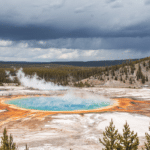Pretty and peaceful, Nova Scotia is Canada’s second smallest province, a peninsula on the eastern edge of the Canadian mainland. But its lengthy coastline is dotted with fishing harbors, sandy beaches, and plump islands. The scenery varies greatly, from the foggy Atlantic Ocean in the southeast to the tidal salt marshes of the Bay of Fundy in the west and Gaelic highlands of Cape Breton to the north. In these maritime latitudes, Nova Scotia has a pleasantly breezy if rather damp climate. Summer is bright and sunny, but weather conditions can often cause fog, with snow in winter.
1. Cabot Trail

A 300 kilometer scenic drive rings the northwest coast of the island and Cape Breton Highlands National Park. It is a coastal route, where the highest mountains in Nova Scotia dramatically meet the Gulf of St. Lawrence. Cliffs, beaches, viewpoints, and a twisting road give countless photo opportunities. Many small communities and attractions line the route, which unofficially begins and ends in Baddeck, home to the father of the telephone, Alexander Graham Bell. Autumn is a favorite time to drive the Cabot Trail owing to the region’s vibrant fall colors.
2. Bay of Fundy

The Bay of Fundy is one of the seven natural wonders of North America, so a visit to this area is sure to be a bucket-list item. Although the majority of the Bay is in nearby New Brunswick, there are sections along the coast to explore in Nova Scotia. The possibilities are truly endless in terms of adventures you could go on here; sea kayaking, hiking, whale watching, three-day canoe trips, and, no joke, walking on the ocean floor.
3. Digby

Many tourists might take one look at this small, sleepy town and pass through without a second thought. But Digby and its surrounding area have some hidden gems that may peak your interest as you make your way through Nova Scotia.
The waterfront in beautiful, and if you’re a fan of scallops, there is no other place in the world you need to try them more than in Digby. This little town has one of the world’s largest scallop fleets, so if you love this awesome seafood, try it here and you won’t be disappointed. Once you’re done enjoying Digby, head out to the Digby Neck, a peninsula that offers incredible views of the Atlantic.
4. Lunenburg

Brightly colored heritage buildings dot the Lunenburg townscape, which is picturesquely set on a hill. The community is a UNESCO World Heritage Site for its legacy as a working port. Along the waterfront, fishermen shovel ice, and vessels dock at the wharves. The town’s most famous craft, however, is the Bluenose schooner. Built here in 1921, the boat won many international races before sinking off the coast of Haiti. A replica Bluenose II is sometimes in port, while other fishing vessels and a schooner can be seen at the Fisheries Museum of the Atlantic.
5. Cheticamp

A fishing village on the Cabot Trail, Cheticamp is surrounded by breathtaking nature, like the scenic point pictured above. If you’re hiking and spending time in the Cape Breton Highlands, this town is a great stop-off.
The advantage of Cheticamp is that you can experience the seaside life that Nova Scotians enjoy, and also explore inland. What is pictured in the above photo is just the tip of the iceberg when it comes to the adventures available in Cheticamp and its surrounding area.
6. Kejimkujik National Park

Kejimkujik National Park is the Maritimes only inland national park, though it does have a seaside adjunct with a stunning white sand beach. The inland area is popular for its lakes and rivers with excellent paddling, historic canoe routes, portages and hiking trails.
7. Peggy’s Cove

About 43 kilometers southwest of Halifax, the fishing village of Peggy’s Cove has a back-in-time feel and sits on the foggy Atlantic Coast. The much-photographed lighthouse marks a perilous point. Stark, wave-battered granite bluffs surround the lighthouse. Fishing wharves, boathouses, colorful heritage homes, and art galleries line the winding road through the community. In September 1998, a Swissair plane crashed off the coast here, killing 229 people.
8. Cape Breton Highlands National Park

The highest peaks in Nova Scotia are in Cape Breton Highlands National Park, which covers more than 950 square kilometers at the northern tip of Cape Breton Island. Both the coastline of beaches and cliffs and the inland forests and rivers tempt hikers, campers, and families to explore the park. Wildlife watching is excellent in the national park with moose, beaver, eagles, and deer often visible from the Cabot Trail scenic drive, which partially cuts through the park.
9. Halifax Harbour

A boardwalk lines the Halifax Harbour, leading from Pier 21 Museum and the Halifax Seaport Farmers Market in the south along to the Maritime Museum of the Atlantic and restaurants. Tugs, sailboats, and navy vessels come and go, and the views look out to Dartmouth across the harbor and Georges Island mid-channel. Near the ferry terminal, “Historic Properties” is a group of restored heritage buildings turned shopping and dining area. A number of sightseeing cruises depart from the waterfront.
10. Fortress of Louisbourg

All the Canadian history buffs should visit this National Historic site in Louisbourg. This fortress is a total recreation of 18th century lifestyles; there are dozens of actors in costumes, from soldiers and servants to fishermen.
You can spend a whole afternoon at this site, as tourists are allowed to walk through and check out the fortress from the inside. The town of Louisbourg is also very quaint and worth seeing once you’re done at the fortress.


